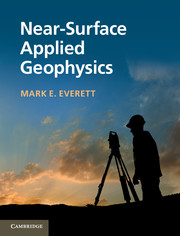Book contents
- Frontmatter
- Contents
- Preface
- Acknowledgments
- 1 Introduction
- 2 Data analysis
- 3 Magnetics
- 4 Electrical resistivity method
- 5 Induced polarization and self-potential
- 6 Seismic reflection and refraction
- 7 Seismic surface-wave analysis
- 8 Electromagnetic induction
- 9 Ground-penetrating radar
- 10 Emerging techniques
- 11 Linear inversion
- 12 Non-linear inversion: local methods
- 13 Non-linear inversion: global methods
- Appendix A Shannon sampling theorem
- Appendix B Solution of Laplace’s equation in spherical coordinates
- Appendix C The linear τ–p transformation of seismic data
- Appendix D Horizontal loop over a conducting halfspace
- Appendix E Radar TE waveguide mode equations
- References
- Index
- Plate section
5 - Induced polarization and self-potential
Published online by Cambridge University Press: 05 April 2013
- Frontmatter
- Contents
- Preface
- Acknowledgments
- 1 Introduction
- 2 Data analysis
- 3 Magnetics
- 4 Electrical resistivity method
- 5 Induced polarization and self-potential
- 6 Seismic reflection and refraction
- 7 Seismic surface-wave analysis
- 8 Electromagnetic induction
- 9 Ground-penetrating radar
- 10 Emerging techniques
- 11 Linear inversion
- 12 Non-linear inversion: local methods
- 13 Non-linear inversion: global methods
- Appendix A Shannon sampling theorem
- Appendix B Solution of Laplace’s equation in spherical coordinates
- Appendix C The linear τ–p transformation of seismic data
- Appendix D Horizontal loop over a conducting halfspace
- Appendix E Radar TE waveguide mode equations
- References
- Index
- Plate section
Summary
The induced-polarization (IP) and and self-potential (SP) methods of geophysical exploration are based on measurements, normally made at the surface of the Earth, of electric potentials that are associated with subsurface charge distributions. In the IP method, the charge distributions are established by an application of external electrical energy. In the SP method, subsurface charge distributions are maintained by persistent, natural electrochemical processes.
Consider the hypothetical situation shown in Figure 5.1 in which electrical charges are distributed unevenly within the subsurface. Charge accumulations are portrayed schematically in the figure as positive and negative “charge centers.” The charges may be volumetrically distributed or they may reside on mineral surfaces and other interfaces. In either case, the regions where charge is concentrated can be viewed as the spatially extended terminals of a kind of natural battery, or geobattery. The sketch shown in the figure greatly simplifies the realistic charge distributions that occur within actual geological formations but it is instructive for the present purpose. Electrical energy supplied from an external source, or energy that naturally arises from a persistent electrochemical process, is required to maintain the “out-of-equilibrium” charge distributions shown in Figure 5.1. Without an energy input, they would rapidly neutralize in the presence of the conductive host medium, and the geobattery would soon discharge.
- Type
- Chapter
- Information
- Near-Surface Applied Geophysics , pp. 104 - 124Publisher: Cambridge University PressPrint publication year: 2013



